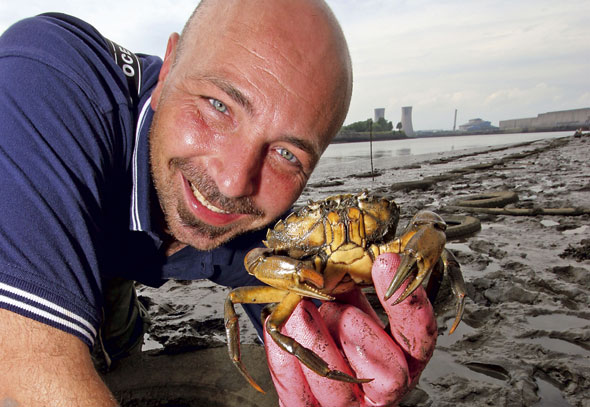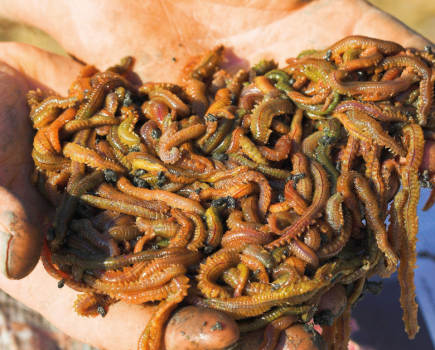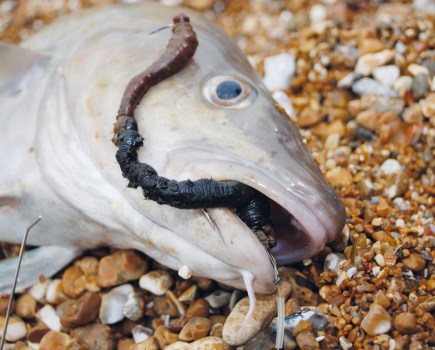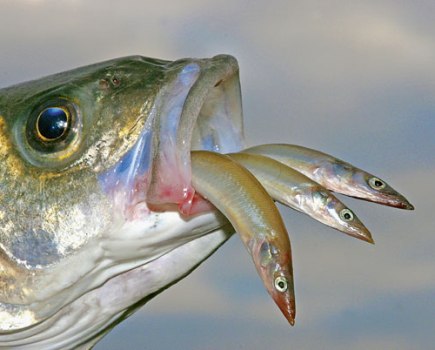Peeler crabs are a must for most match anglers…for everyone else they are an enigma, being misunderstood and rarely used. They are certainly not a license to catch fish and there are times when worms are a better hook bait. Along my local North East coast peelers are seen as the top bait for cod and coalfish most of the year and for flounders and eels during the summer, particularly for fishing estuaries and rivers.
A juicy crab will also tempt whiting, pouting and plaice. It’s a good bait for dabs if mounted on a small hook; try a few peeled legs mounted as if they were worms on a small Aberdeen.
In other parts of the country the powerful scent given off by a crab will take smoothhounds, bass and rays. Wrasse are fond of crab baits and will even take a float-fished hardback.
The scientific way to measure a crab is across the back of the shell (carapace) from between the eyes to where the rear legs join. All crabs have ten legs, including the claws, and of all species the one that interests most anglers is the common shore crab (Carcinus maenas).
There are a few other species that are also of interest to anglers, such as the edible and the increasingly common velvet swimming crab, both of which make an excellent bait if they can be obtained and kept alive in cool oxygenated seawater.
Edible crabs are subject to size limits, which vary from area to area and in the north-east region it is illegal to use them for bait. There are moves to limit the collection of commons in the same area. Crabs are crustaceans, their soft body being protected by a hard outer shell, which unfortunately, for the crab, doesn’t grow. Instead a soft shell forms under the old hard carapace and when the crab outgrows the old shell it discards it to reveal the new soft shell underneath.
This new shell takes time to harden, so to stay out of the way of predators it hides. If you find a crab in this soft stage it is a ‘softie’ and can be used for bait. However, at this stage the crab is full of water, which it uses to pump itself up before the new shell hardens.
It is far better to find a crab actually in the pre-moulting stage before the hard shell is discarded, in this condition it is a ‘peeler’ and is a lot more effective as bait, because it is full of natural body juices and not inflated by excess sea water.
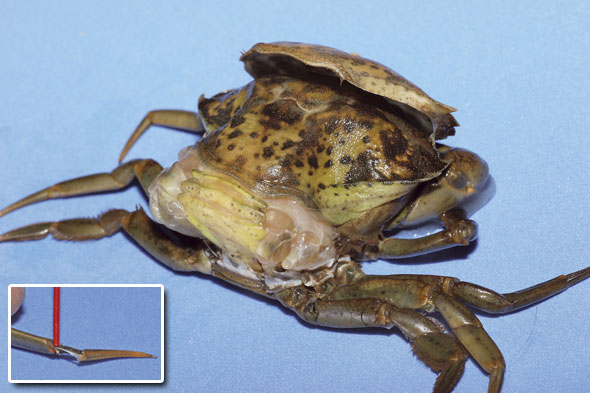
A crab in the advanced stage of peeling and, inset, a soft back leg is revealed
How to harvest crabs
There are two main ways to collect crabs. You can either scour a rocky shoreline by turning over boulders and weed and searching rocky crevices. Alternatively, you can actively trap crabs by placing sections of drainpipe or old car tyres along the shoreline.
The best place to do this is in sheltered harbours or muddy estuaries where there is not too much natural cover for the crabs to hide. By placing traps in this type of environment the crabs are almost obliged to seek refuge in them because there is nowhere else to go.
They are hard work to set up, but, once installed, they can produce a regular supply of crabs throughout the summer and in some regions even in the winter. Some anglers might have several hundred traps and they are jealously guarded against thieves.
I know of some anglers who turn up just after high water where their traps are and wait for the tide to ebb just in case anyone else gets there first. The general view is that traps belong to the person who set them but the crabs belong to anyone, however, I wouldn’t advise that you rob another man’s traps.
I’m happy to forage along the shoreline making sure that any rocks turned over are replaced in the original position. Make sure any weed is always left showing on the top, and not underneath a rock because it quickly turns into a smelly gooey mess, which prevents anything from seeking shelter.
Here in the northeast the main peeler period is around mid-May when the male crabs start to peel and there is usually a two-week period when the majority of them peel, which is usually triggered by water temperature and daylight hours. Either side of this period there will still be peelers available but in lesser numbers.
They tend to show in the sheltered estuaries and harbours first and then they can usually be found along the rock edges a few weeks later. So, the angler who has traps in place can have an extended season by starting off in the sheltered estuaries where his traps are and then moving onto the local rock edges later.
By the middle of June the male peelers have nearly all disappeared, but by July the females start to peel when they can often be found as ‘carriers’. This is part of the reproduction process as mating can only take place shortly after the female crab has moulted.
The male crab finds a female prior to moulting and carries her around beneath his body for a number of days, and after she has moulted fertilisation occurs. The female then creates a cavity by burrowing in sand, where she lays her eggs. While positioned over this cavity, she then attaches the eggs to her legs and underneath the lower flap on her abdomen and carries them around for several months. In this state the crab is said to be berried.
If you are lucky enough to find a sandy/muddy sheltered beach on a big low tide it is often possible to pick up a great number of carried female peelers by looking for the top of the male crab buried in the sand. After the eggs hatch the larvae are planktonic for two to three years. They then settle as young crabs and reach maturity after around a year.
To quickly tell the difference between a male and female crab you need to turn the crab upside down and look at the abdomen flaps. The female flap is larger and rounder than the male, which is smaller and narrower and has a more pointed end to it.
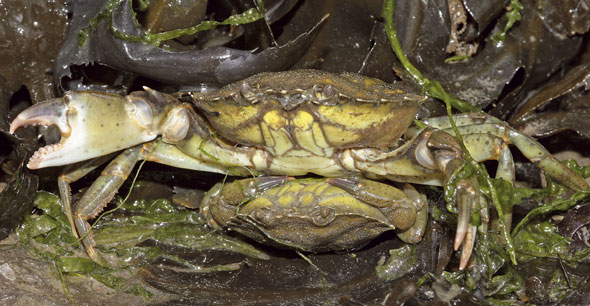
The female crab on the bottom is upside down below the male, meaning she has peeled, is a softie or crinkleback, and is mating
There’s a second moult
Around late August and early September the male crabs undergo a second peel and again you may find that they peel over several days.
Big low tides are prime collecting times when crabs can be found in large numbers around the lower rock edges. Not all crabs are peelers, but with a bit of practise you can tell a peeler crab from a hardback. Generally crabs collected from the open shoreline are more colourful than those gathered in an estuary, which tend to be a more uniform dirty green-grey colour.
Shoreline peelers tend to be a brighter yellow orange colour than non-peelers, which are more uniform green/yellow. It is difficult to tell peelers collected from an estuary by colour alone and the best way to tell is to gently break off the rear segment of a back leg.
This will reveal a soft new leg section underneath if it is a peeler or just some white muscular tissue if it is not. If you do this carefully it will not harm the crab as it is designed to suffer the loss of legs, a membrane quickly covers the broken off section which stops the crab from bleeding. The lost part either grows or is replaced at the next moulting stage.
Why they walk sideways
It due to the fact that it’s the way their legs bend. Muscles work in pairs and can only retract or extend, one muscle relaxes and is then pulled back by the second muscle to produce movement.
The muscle pairs in crabs are attached to the inner surface of the skeleton, including the legs and claws.
Crabs do not have ball and socket joints like us, but have legs that pivot at numerous push-in socket joints that are sealed by a flexible membrane. They can only move in one plane. Each joint on a leg, however, moves in a different plane and when co-ordinated to work together these crabs can move in all directions.

Keeping a diary will enable you to track the best times of the year and venues to collect crabs. You can also use it to track your catches, best venues and tides. Don’t let your mates see it, though!

